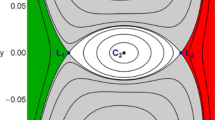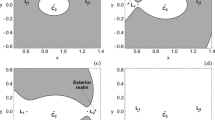Abstract
The orbital dynamics of a spacecraft, or a comet, or an asteroid in the Earth-Moon system in a scattering region around the Moon using the three dimensional version of the circular restricted three-body problem is numerically investigated. The test particle can move in bounded orbits around the Moon or escape through the openings around the Lagrange points \(L_{1}\) and \(L_{2}\) or even collide with the surface of the Moon. We explore in detail the first four of the five possible Hill’s regions configurations depending on the value of the Jacobi constant which is of course related with the total orbital energy. We conduct a thorough numerical analysis on the phase space mixing by classifying initial conditions of orbits in several two-dimensional types of planes and distinguishing between four types of motion: (i) ordered bounded, (ii) trapped chaotic, (iii) escaping and (iv) collisional. In particular, we locate the different basins and we relate them with the corresponding spatial distributions of the escape and collision times. Our outcomes reveal the high complexity of this planetary system. Furthermore, the numerical analysis suggests a strong dependence of the properties of the considered basins with both the total orbital energy and the initial value of the \(z\) coordinate, with a remarkable presence of fractal basin boundaries along all the regimes. Our results are compared with earlier ones regarding the planar version of the Earth-Moon system.



















Similar content being viewed by others
Notes
For the value of the mass ratio \(\mu\) we adopted the same precision (number of significant decimal digits) as in Paper I.
In Paper I the authors classified two dimensional orbits with \(\dot{x_{0}} = 0\) and \(\dot {y_{0}} > 0\). In our work we expand into three dimensions this choice of initial conditions thus considering orbits with \(\dot{x_{0}} = \dot{z_{0}} = 0\) and \(\dot{y_{0}} > 0\). The case with non-zero values in \(x\) and \(z\) components of the velocity of the test particle is another choice which however is not considered here, obviously for saving space.
The set of initial conditions of orbits which lead to a certain final state (escape, collision or bounded motion) is defined as a basin.
Obviously, if we numerically integrate initial conditions inside this region we will see that they lead to immediate collision to the Moon.
When we state that an area is fractal we simply mean that it has a fractal-like geometry without conducting any specific calculations as in Aguirre et al. (2009).
References
Aguirre, J., Vallego, J.C., Sanjuán, M.A.F.: Wada basins and chaotic invariant sets in the Hénon-Heiles system. Phys. Rev. E 64, 066208 (2001)
Aguirre, J., Viana, R.L., Sanjuán, M.A.F.: Fractal structures in nonlinear dynamics. Rev. Mod. Phys. 81, 333–386 (2009)
Barrio, R., Blesa, F., Serrano, S.: Fractal structures in the Hénon-Heiles Hamiltonian. Europhys. Lett. 82, 10003 (2008)
Barrio, R., Blesa, F., Serrano, S.: Bifurcations and safe regions in open Hamiltonians. New J. Phys. 11, 053004 (2009)
Benet, L., Trautman, D., Seligman, T.: Chaotic scattering in the restricted three-body problem. I. The Copenhagen problem. Celest. Mech. Dyn. Astron. 66, 203–228 (1996)
Benet, L., Seligman, T., Trautman, D.: Chaotic scattering in the restricted three-body problem II. Small mass parameters. Celest. Mech. Dyn. Astron. 71, 167–189 (1998)
Bleher, S., Grebogi, C., Ott, E., Brown, R.: Fractal boundaries for exit in Hamiltonian dynamics. Phys. Rev. A 38, 930–938 (1988)
Bleher, S., Ott, E., Grebogi, C.: Routes to chaotic scattering. Phys. Rev. Lett. 63, 919–922 (1989)
Contopoulos, G.: Asymptotic curves and escapes in Hamiltonian systems. Astron. Astrophys. 231, 41–55 (1990)
Contopoulos, G.: Order and Chaos in Dynamical Astronomy. Springer, Berlin (2002)
Contopoulos, G., Kaufmann, D.: Types of escapes in a simple Hamiltonian system. Astron. Astrophys. 253, 379–388 (1992)
Contopoulos, G., Kandrup, H.E., Kaufmann, D.: Fractal properties of escape from a two-dimensional potential. Physica D 64, 310–323 (1993)
de Assis, S.C., Terra, M.O.: Escape dynamics and fractal basin boundaries in the planar Earth-Moon system. Celest. Mech. Dyn. Astron. 120, 105–130 (2014), (Paper I)
de Moura, A.P.S., Grebogi, C.: Countable and uncountable boundaries in chaotic scattering. Phys. Rev. E 66, 046214 (2002)
de Moura, A.P.S., Letelier, P.S.: Fractal basins in Hénon-Heiles and other polynomial potentials. Phys. Lett. A 256, 362–368 (1999)
Ernst, A., Peters, T.: Fractal basins of escape and the formation of spiral arms in a galactic potential with a bar. Mon. Not. R. Astron. Soc. 443, 2579–2589 (2014)
Hénon, M.: Numerical exploration of the restricted problem, V. Astron. Astrophys. 1, 223–238 (1969)
Jung, C., Tél, T.: Dimension and escape rate of chaotic scattering from classical and semiclassical cross section data. J. Phys. A 24, 2793–2805 (1991)
Jung, C., Mejia-Monasterio, C., Seligman, T.H.: Scattering one step from chaos. Phys. Lett. A 198, 306–314 (1995)
Jung, C., Lipp, C., Seligman, T.H.: The inverse scattering problem for chaotic Hamiltonian systems. Ann. Phys. 275, 151–189 (1999)
Kandrup, H.E., Siopis, C., Contopoulos, G., Dvorak, R.: Diffusion and scaling in escapes from two-degrees-of-freedom Hamiltonian systems. Chaos 9, 381–392 (1999)
Kennedy, J., Yorke, J.A.: Basins of Wada. Physica D 51, 213–225 (1991)
Lai, Y.-C., Tél, T.: Transient Chaos. Springer, New York (2011)
Lyapunov, A.: Probléme General de las Stabilité de Mouvement. Ann. Math. Stud., vol. 17 (1949)
Nagler, J.: Crash test for the Copenhagen problem. Phys. Rev. E 69, 066218 (2004)
Nagler, J.: Crash test for the restricted three-body problem. Phys. Rev. E 71, 026227 (2005)
Navarro, J.F., Henrard, J.: Spiral windows for escaping stars. Astron. Astrophys. 369, 1112–1121 (2001)
Poon, L., Campos, J., Ott, E., Grebogi, C.: Wada basins boundaries in chaotic scattering. Int. J. Bifurc. Chaos 6, 251–266 (1996)
Press, H.P., Teukolsky, S.A., Vetterling, W.T., Flannery, B.P.: Numerical Recipes in FORTRAN 77, 2nd edn. Cambridge University Press, Cambridge (1992)
Schneider, J., Tél, T.: Extracting flow structures from tracer data. Ocean Dyn. 53, 64–72 (2003)
Schneider, J., Tél, T., Neufeld, Z.: Dynamics of “leaking” Hamiltonian systems. Phys. Rev. E 66, 066218 (2002)
Seoane, J.M., Aguirre, J., Sanjuán, M.A.F., Lai, Y.C.: Basin topology in dissipative chaotic scattering. Chaos 16, 023101 (2006)
Seoane, J.M., Sanjuán, M.A.F., Lai, Y.C.: Fractal dimension in dissipative chaotic scattering. Phys. Rev. E 76, 016208 (2007)
Simó, C., Stuchi, T.: Central stable/unstable manifolds and the destruction of KAM tori in the planar Hill problem. Physica D 140, 1–32 (2000)
Skokos, C.: Alignment indices: a new, simple method for determining the ordered or chaotic nature of orbits. J. Phys. A, Math. Gen. 34, 10029–10043 (2001)
Szebehely, V.: Theory of Orbits. Academic Press, New York (1967)
Tuval, I., Schneider, J., Piro, O., Tél, T.: Opening up fractal structures of three-dimensional flows via leaking. Europhys. Lett. 65, 633–639 (2004)
Wolfram, S.: The Mathematica Book. Wolfram Media, Champaign (2003)
Zotos, E.E.: A Hamiltonian system of three degrees of freedom with eight channels of escape: the great escape. Nonlinear Dyn. 76, 1301–1326 (2014a)
Zotos, E.E.: Escapes in Hamiltonian systems with multiple exit channels: Part I. Nonlinear Dyn. 78, 1389–1420 (2014b)
Zotos, E.E.: Revealing the escape mechanism of three-dimensional orbits in a tidally limited star cluster. Mon. Not. R. Astron. Soc. 446, 770–792 (2015a)
Zotos, E.E.: Escapes in Hamiltonian systems with multiple exit channels: Part II. Nonlinear Dyn. 82, 357–398 (2015b)
Zotos, E.E.: Orbital dynamics in the planar Saturn-Titan system. Astrophys. Space Sci. 358, 4 (2015c)
Zotos, E.E.: Orbit classification in the planar circular Pluto-Charon system. Astrophys. Space Sci. 360, 7 (2015d)
Zotos, E.E., Caranicolas, N.D.: Order and chaos in a new 3D dynamical model describing motion in non-axially symmetric galaxies. Nonlinear Dyn. 74, 1203–1221 (2013)
Acknowledgements
I would like to express my warmest thanks to the anonymous referee for the careful reading of the manuscript and for all the apt suggestions and comments which allowed us to improve both the quality and the clarity of the paper.
Author information
Authors and Affiliations
Corresponding author
Rights and permissions
About this article
Cite this article
Zotos, E.E. Escape dynamics and fractal basins boundaries in the three-dimensional Earth-Moon system. Astrophys Space Sci 361, 94 (2016). https://doi.org/10.1007/s10509-016-2683-6
Received:
Accepted:
Published:
DOI: https://doi.org/10.1007/s10509-016-2683-6




